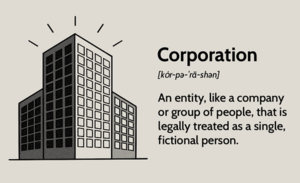Corporation
A traditional corporate entity is a collective joined together by articles of incorporation in pursuit of profit. Although it may be comprised of individual parts such as directors, officers, and shareholders, a corporation is a legal entity in and of itself. This was determined by Santa Clara County vs Southern Pacific Railway in the US Supreme court in 1886[2]. In essence, this case was a dispute over a railway route in the US and determined whether the Supreme Court identified a private corporation as a “natural person” under the U.S. Constitution and therefore entitled to protection under the Bill of Rights.
Behaviour
The prime driver of all corporate entities is self survival. The second, is their fiduciary duty to pursue revenue for the financial gain of employees and shareholders. These paramount, binding principles gives corporations a machine like quality which if it was a REAL person would meet the diagnostic criteria for psychopathy[1]. These general traits of corporations are compounded by the fact that people with narcissistic traits tend to get promoted 39% faster in their progression to CEO[3] resulting in at least three times as many psychopaths in executive or CEO roles than in the overall population[4]. Psychopathic behaviour is bad, for everyone, as they only amount to 1% of the adult population, but are reported to be responsible for about 50 % of all serious crimes and constitute 20% of (North American) prison populations[5].
As we live in a type of corporatocracy, where corporates are the dominant organisational form on earth as they sell us most stuff (see Figure 1 and Figure 2) this may seem depressing. However, a ray of hope is to remember corporations have only been around for 0.16% of the time since humans evolved are simply inert machines. Much like a gun, corporate behaviour is only defined by the intention defined in its foundational coding, its incorporation statement, which can be rewritten. Perhaps, if one can change the primary intention, we can change the effect. Could a series of hierarchical rules (tenets) be written as a precursor to a legally binding incorporation statement lead to a creation of a machine which does good?
Corporate Take Over
Many new business have started with the idea of changing the status quo, however more often than not as they grow, mounting financial pressures require the further pursuit of profit often sacrificing ethical concerns. One recent example of this is the Sea Shepherd organisation. Sea Shepherd started as a renegade navy (pirates?) which aimed to illegally sink Japanese whaling ships in the name of sea ecology conservation. The organisation grew from one ship to over 20 and to manage this incorporated in the US. However, once a board was established their previous actions were deemed too renegade and as a consequence pushed out their founding member Captain Paul Watson. Sea Shepherd then changed its remit from renegade action towards training and education.
This example, alongside the more famous removals "Do No Evil" from Google's manifesto highlights how there is a creeping need in traditional organisations towards corporatism. To resolve this issue any initial Tenets that describe the operations of an organisation need to be in read only format.
References
- ↑ 1.0 1.1 The Corporation: The Pathological Pursuit of Profit and Power. Bakan, Joel, New York: Free Press, 2004. https://thecorporation.com/
- ↑ 2.0 2.1 Santa Clara County v. Southern Pacific, U.S. Supreme Court (1886): 118 U.S. 394. Decided: May 9, 1886. Accessed 6th Jan 2022 via https://supreme.justia.com/cases/federal/us/118/394/
- ↑ The perks of narcissism: Behaving like a star speeds up career advancement to the CEO position. The Leadership Quarterly: Published June 2021, Accessed 28th September 2022 via https://doi.org/10.1016/j.leaqua.2020.101489
- ↑ Corporate Psychopathy: Talking the Walk. Paul Babiak, Ph.D.y, Craig S. Neumann, Ph.D.z and Robert D. Hare, Ph.D. Behavioral Sciences and the Law. Behav. Sci. Law 28: 174–193 (2010). Published online 6 April 2010 in Wiley InterScience DOI: 10.1002/bsl.925. Accessed on 28 September 2022 via https://www.sakkyndig.com/psykologi/artvit/babiak2010.pdf
- ↑ Without conscience: The disturbing word of the psychopaths among us. Hare, R. (1999). New York: Guildford Press. https://www.google.com/books/edition/_/xfIEVtzj52YC?hl=en
